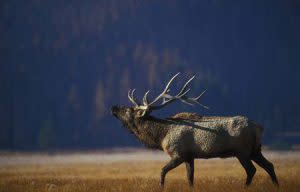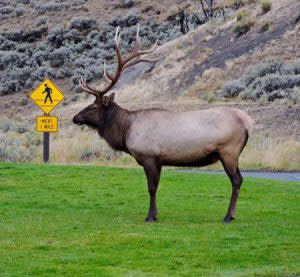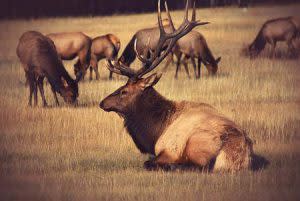Big Sky Wildlife Spotlight: Elk

Herds of elk call Big Sky, Montana their home. These majestic creatures will often congregate in large meadows like the Big Sky Resort golf course or near Lone Mountain Ranch. It's common to spot elk in Big Sky or to find shed horns during your hikes. Keep your eyes peeled and you might see or hear an elk while you're in town. They are definitely around these parts.
Here are a few fun and interesting facts about Elk to share with your friends:
- The scientific name for elk is Cervus canadensis.
- Elk are native to North America and Eastern Asia, but have been introduced to other countries and continents too.
- Elk are one of the largest species of deer in the world.
- Elk live in mountain meadows and forests.
- They are herbivores that eat grass, bushes, and saplings.
- Elk have a four chamber stomach that aids digestion.
- Males are called bulls. Females are called cows. Newborns are called calfs.
- A group of elk is called a herd or a gang.
- Only males grow antlers.
- Antlers shed annually at the onset of winter and regrow in spring before mating season.

Michael Holston | Shutterstock
- Antlers grow at up to an inch per day as blood flows to them.
- Antlers can weigh up to 40 pounds.
- The more spread out the antlers, the more attractive the bull is to the cow.
- Antlers can reach up to 4 feet above a bull's head.
- While the antlers are growing, they are covered in a fuzzy skin called velvet.
- Bulls often use their antlers to fight.
- Elk breed in the fall during the rut.
- Gestation takes 240 to 262 days and usually results in one spotted calf. The spots disappear by the end of the first summer.
- Calves can stand on their own within 20 minutes of birth.
- Wolves, coyotes, cougars, lions, and bears prey on elk.
- When alarmed, elk raise their heads high, open their eyes wide, and rotate their ears.
- In order to communicate with each other, elk curl their upper lip, make hissing sounds, and grind their teeth.
- Bulls protect small groups of cows and calves called harems. These harems can include up to 20 cows.
- The sound an elk makes is called a bugle. The sound can carry for miles.
- Elk can live 8 to 12 years in the wild.
- Elk are 4 to 5 feet tall at the shoulder.
- Elk weigh between 325 to 1100 pounds.
- Elk will eat 4 to 7 kg of food daily.
- Ancient elk used to have tusks.
- An elk's top two canine teeth are called ivories.
- The state of Montana has the second-largest elk population in the country, with 150,000 elk.
- Elk are often called wapiti - a Shawnee word meaning "white rump."
- Elk can run up to 40 miles per hour, beat horses in short races, and jump up to 8 vertical feet.

- Crow Indian Wedding dresses are often decorated in elk canine teeth.
- The journals of Lewis and Clark were bound in elk hide.
- Elk will change colors throughout the year.
- Elk hunting is a popular activity throughout Montana.
Elk are a mainstay in Big Sky country. It's important to keep your eyes peeled for them while driving. If you see one in the wild, give it plenty of space as elk can become protective. They have been known to charge and gore humans who threaten their territory.
Elk are also quite tasty. Browse the local menus and you'll see several elk recipes that you'll most certainly enjoy.
See Also:
- Big Sky Wildlife Spotlight: Moose
- Big Sky Wildlife Spotlight: Bighorn Sheep
- Big Sky Wildlife Spotlight: Wolves
- Big Sky Wildlife Spotlight: Mountain Goats

